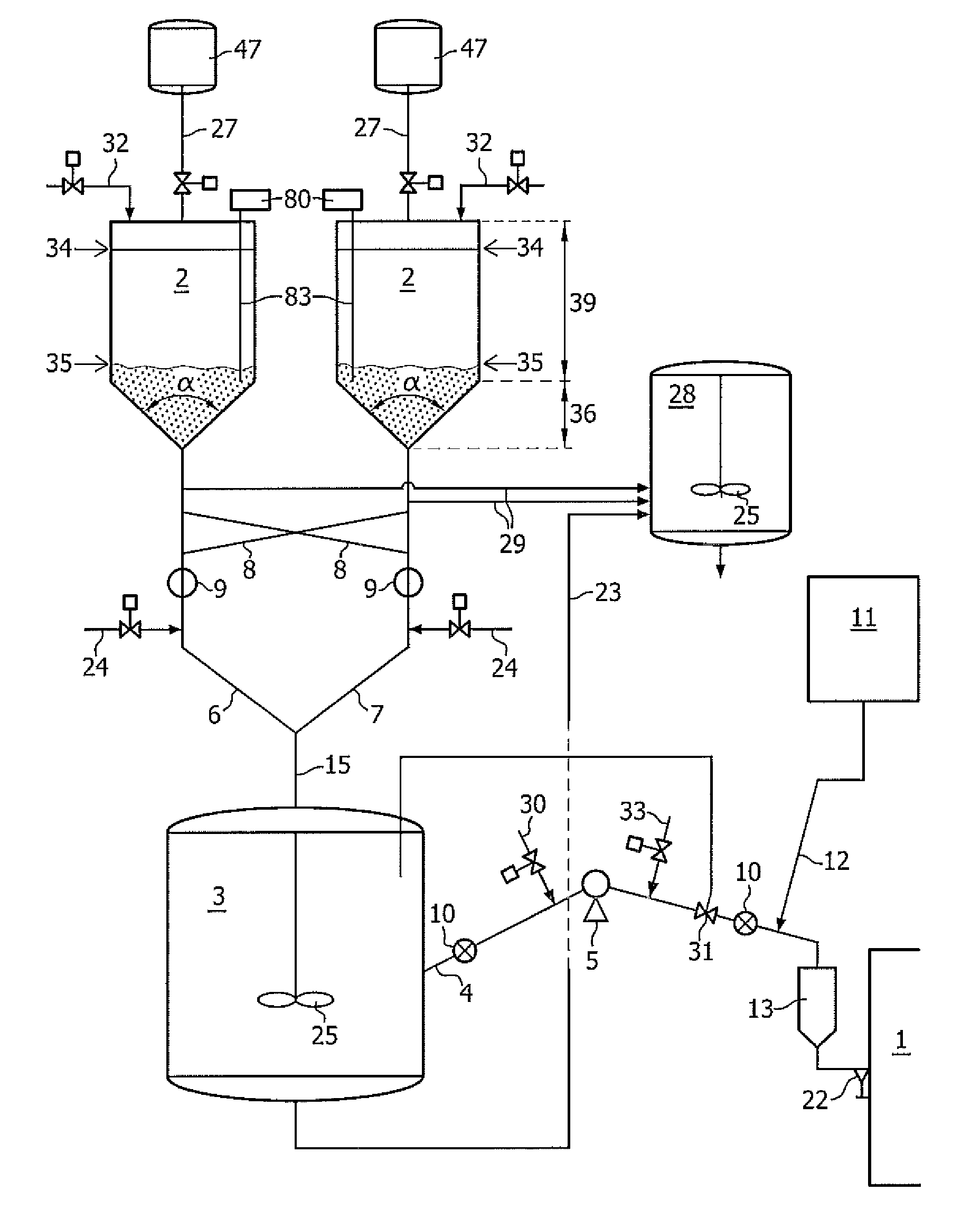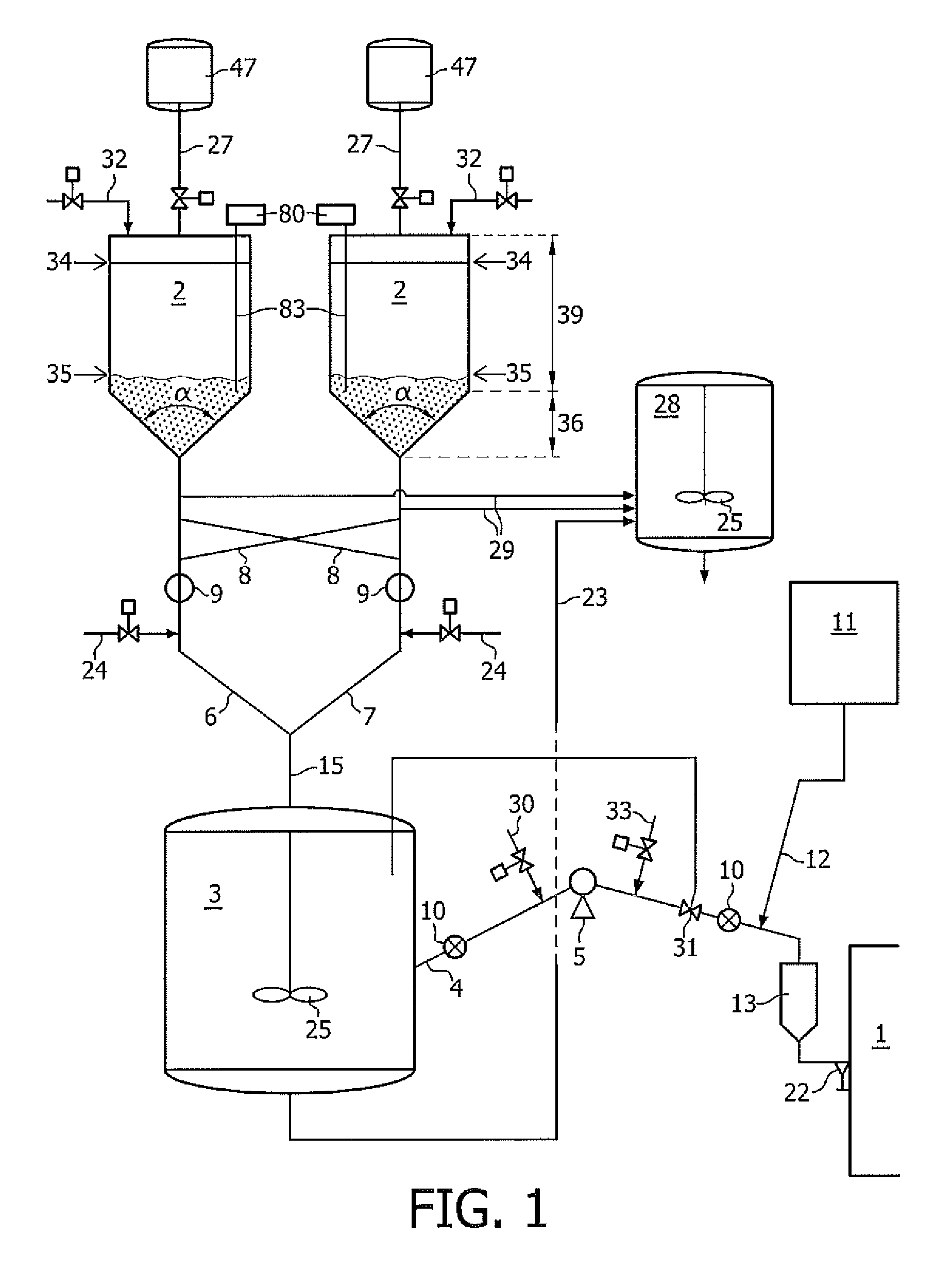Method for replacing incompatible ethylene polymerization catalysts
a technology of ethylene polymerization catalyst and incompatible ethylene, which is applied in the field of replacing incompatible ethylene polymerization catalysts, can solve the problems of long transition period, unsuitable for further use production of transition materials, and long transition period, so as to reduce the amount of transition products produced, the effect of reducing complications
- Summary
- Abstract
- Description
- Claims
- Application Information
AI Technical Summary
Benefits of technology
Problems solved by technology
Method used
Image
Examples
example 1
[0119]This example describes the transition from a chromium-based catalyst to a metallocene catalyst in the polymerization of ethylene.
[0120]A first mud pot capable of holding 300 kg of catalyst was loaded with chromium-based catalyst. Commercially available catalyst was used. The catalyst was fed to a mixing vessel in form of a slurry. The slurry was prepared by mixing the chromium catalyst from the mud pot with isobutane. A polymerization was performed in a double loop ethylene polymerization reactor. The polymerization reaction ran using chromium-based catalyst for a period of 1 day.
[0121]Flow rate of isobutane was increased, thereby diluting the chromium catalyst concentration in the conduit connecting the mud pot to the mixing vessel. Upon reaching a desired concentration of chromium catalyst in the mixing vessel, the content of the mixing vessel was emptied into a dumping vessel.
[0122]The ethylene feed to the reactor was stopped. The reactor was emptied and rinsed with water c...
example 2
[0125]The hereunder-described device, illustrated by FIG. 1, corresponds to equipment suitable for carrying out the method of the invention. Example 2 will illustrate the use of a method of the invention for the sequential feeding of at least two incompatible ethylene polymerization catalysts in an ethylene polymerization reactor plant.
[0126]A metallocene catalyst is solid and is generally provided under a dry form in commercially available packaging.
[0127]Depending on the diluent used, it may be required to bring the catalyst under higher pressure conditions. This is for instance the case when isobutane is used, since this diluent is only liquid at higher pressure levels. In case for instance hexane is used as diluent, pressurization is not required, since this diluent is liquid at low pressures.
[0128]Preferably pressurizeable catalyst supply containers are used. Pressurizeable containers may be suitable for direct use and coupling to an inlet provided on the mud pot. Use of a larg...
example 3
Transition of Non-Compatible Catalysts
[0156]1. A first polyethylene is produced using a Cr-based catalyst under normal operating conditions in a polymerization slurry loop reactor with an ethylene off-gas concentration of 8 wt %. The catalyst slurry in the mixing vessel had a concentration of 3 wt %.[0157]The transfer from the Cr-based catalyst to the metallocene catalyst is performed as follows:[0158]2. The isobutane diluent to the mixing vessel having a volume of 500 L is increased gradually from 70 to 150 kg / hr over a period of 2 hours.[0159]3. The ethylene feed is kept constant during the transition to reduce the ethylene off-gas of the polymerization slurry loop reactor.[0160]4. When an ethylene off-gas of 3 wt % is obtained, the Cr catalyst supply to the mixing vessel is stopped.[0161]5. The ethylene feed to the polymerization reactor is stopped simultaneously.[0162]6. The polymer product and catalyst slurry which circulate in the loop reactor are removed over a period of 6 ho...
PUM
| Property | Measurement | Unit |
|---|---|---|
| concentration | aaaaa | aaaaa |
| time | aaaaa | aaaaa |
| melt flow index | aaaaa | aaaaa |
Abstract
Description
Claims
Application Information
 Login to View More
Login to View More - R&D
- Intellectual Property
- Life Sciences
- Materials
- Tech Scout
- Unparalleled Data Quality
- Higher Quality Content
- 60% Fewer Hallucinations
Browse by: Latest US Patents, China's latest patents, Technical Efficacy Thesaurus, Application Domain, Technology Topic, Popular Technical Reports.
© 2025 PatSnap. All rights reserved.Legal|Privacy policy|Modern Slavery Act Transparency Statement|Sitemap|About US| Contact US: help@patsnap.com


